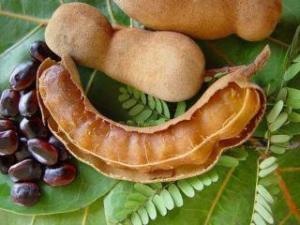5 Exotic Fruits That You Haven’t Heard Of
This summer I can’t travel. It is really a sad fact, but one year post college, I just haven’t accrued the funds to gallivant the world like my heart desires (I mean…in this economy?!). So instead, I have been plotting an endless amount of trips in my head. Most involve Southeast Asia, with a combination of beaches, fish, beverages, beverage with fruit, fruit alone, and awesome people. Since ‘fruit alone’ is healthiest item on my consumption list, I’m going embrace my inner-traveler by blogging about exotic fruits. Specifically, I want to talk about five fruits that most Americans haven’t heard of, and that I plan on gorging on when I finally make it abroad.
You’ll notice that I mention traditional medicinal uses of the fruits. Most of these medicinal uses have not been vetted through rigorous scientific examination, but are interesting to learn about regardless. FoundHealth.com does not actually endorse these medicinal uses! Enjoy, and I hope to catch you on the beaches of Bali soon enough…
Mangosteen:
Origins: Southeast Asia, densely concentrated in Thailand.
Mouthwatering Description: When ripe, the crimson rind should peel away easily. Score the shell with a knife, hold fruit in both hands, pry gently along the score with your thumbs, and pull in half. Inside is a fibrous, white flesh, full of sweet and tangy flavor. The tangy flavor strikes first before melting into a sweeter flavor.
Traditional Medicinal Uses: Mangosteen’s rind is powdered and made into an ointment, and subsequently used to relieve dysentery, cystitis (bladder inflammation), gonorrhea and more. In Malaya, an infusion of mangosteen leaves, combined with unripe banana and benzoin, is applied to the wound caused by circumcision.
Lychee:
Origins: Lychee is native to the low elevations of Southern China, thriving by rivers and seacoast. They can be found prevalently in India, Southeast Asia, Brazil, South Africa, and some parts of Australia.
Mouthwatering Description: Growing in clusters, lychees are generally walnut sized, with strawberry-red, pinkish, or amber colors. The skin is thin, bumpy, and rough, but is easily peeled when ripe. Inside the rough exterior awaits a smooth surprise: a translucent-white flesh surrounding a seed, resembling a luscious grape. The sweet and juicy fruit has a moderately sharp and uniquely distinctive flavor.
Traditional Medicinal Uses: In China, lychee seeds are credited with analgesic properties, and thus are administered for neuralgia (nerve pain). Interestingly, the seed grinds are also given for orchitis (testicle inflammation). In India, the seeds are powdered and given for intestinal issues, and like China, the lychee is known for its analgesic properties. On the flipside, the Chinese say over-consumption of lychee can cause fever and nosebleeds. As legend has it, men used to eat anywhere from 300 to 1,000 lychees, and the results were not so good…
Longan:
Origins: Longan, a fruit similar to lychee, is also native to Southern China, but is not as well regarded. It is also claimed to be native to southwestern India, but the jury is still out (it is a super passionate & completely necessary debate…). It continues to grow in both countries, along with Thailand, Cambodia, Laos, Vietnam and Taiwan. Interestingly, the Longan tree grows in the Philippines, but does not fruit.
Mouthwatering Description: Smaller than a Lychee and growing in clusters, Longan has a yellow to reddish-brown exterior, and a smoother surface than Lychee. After cracking the shell, you’ll find an eyeball staring directly at you. Ok, not really. But the Longan seed is round, jet-black, and shining, with a circular white spot at the base, causing it to resemble an eye. The flesh of Longan is musky and sweet, but not as sweet at the Lychee.
Traditional Medicinal Uses: The fruit’s flesh is administered to promote digestion, to fight fever, and also to fight parasitic worms. Most interestingly, it is used as an antidote for poison. In both North and South Vietnam, the ‘eye’ of the Longan seed is pressed against snakebites with the belief that it will absorb the venom.
Tamarind:
Origins: Tamarind originated in Sudan, but was quickly adopted and embraced by India. It has long grown in the East Indies and Pacific Islands, and is grown in large quantities throughout Mexico. You can even find some in Southern Florida.
Mouthwatering Description: Tamarind’s exterior isn’t necessarily cause for salivation. The fruit, usually between 2-7 inches long, has a cinnamon to grayish-brown hue. Under the brown skin, which cracks like an eggshell when ripe, is gooey brown pulp that coats a string of seeds. The pulp has a strong tart-sweet flavor. Tamarind is prevalently consumed in sauce and chutney form.
Traditional Medicinal Uses: Tamarind possesses innumerable health benefits that have been recognized by even Western medical institutions. In Ayurvedic Medicine, it is used for gastric and digestion issues, as well as cardioprotective activity. Tamarind’s digestion enhancing properties are strong enough that it is administered to elephant’s whose stomachs are on the fritz. It was recently discovered that the fruit could also lower blood pressure and cholesterol levels. Its leaves and roots are used for treatment of leprosy. These benefits are just the tip of the iceberg. Moral of the story: EAT TAMARIND!
Jackfruit:
Origin: Jackfruit is native to Southern Asia, perhaps originating in the Western mountain ranges of India. It now grows is India, Burma, Southern China, and is common in the Philippines. In case you can’t make out to Asia, there are also jackfruits growing in Brazil.
Mouthwatering Description: Jackfruit is the largest of all tree-borne fruits, capable of growing up to 3 feet long to 20 in long, and weighing in at as much as 110 lbs! One of these bad boys could feed a village. When ripe, the rind will be either green or yellow. The interior consists of large bulbs of yellow, banana-flavored flesh, with each bulb containing a smooth, oval seed. At its finest, the bulb will smell like a pineapple and banana (kind of like my favorite cocktail). Oddly enough, at its best, an unopened jackfruit will have a rotten onion smell. Don’t let that sneaky scent fool you. Eat up!
Traditional Medicinal Uses: Speaking of my favorite cocktail, Jackfruit pulp, being cooling and nutritious, is considered to be useful in overcoming the influence of alcohol on the system, according to the Chinese. The ash of roasted jackfruit leaves is thought to heal ulcers, while heated leaves are placed on wounds. Lastly, roasted jackfruit seeds are regarded as an aphrodisiac. Now you have no reason not to eat one!
What are your favorite exotic fruits? Where in the world can I find them? Please share by leaving a comment below!
Join Our Community
Archives
- January 2023
- December 2022
- September 2022
- August 2022
- June 2022
- May 2022
- April 2022
- March 2022
- February 2022
- January 2022
- December 2021
- November 2021
- October 2021
- September 2021
- August 2021
- July 2021
- June 2021
- May 2021
- March 2021
- September 2020
- August 2020
- July 2020
- June 2020
- May 2020
- April 2020
- March 2020
- February 2020
Subscribe

Sign up to receive FREE toolkit
From Dr. Hyman, #1 NY Times & Amazon Author
We never spam or sell your e-mail








Follow Our Every Move